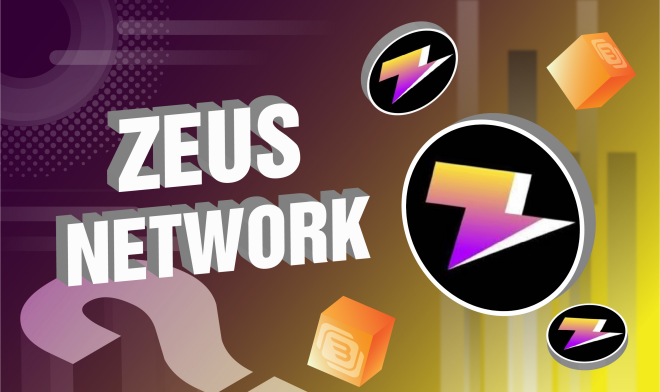
In the crypto market in 2024, Bitcoin and Solana are undoubtedly the most eye-catching stars. With the passage of the Bitcoin spot ETF, the influx of over-the-counter funds in the market has caused the price of Bitcoin to soar. At the same time, the Solana ecosystem is also developing rapidly. From DePIN represented by Helium, to AI represented by BitTensor, to the hardware and Meme culture of Saga and Bonk, Solana has become an independent and prosperous ecosystem.
The birth of Zeus Network
Against this background, Jupiter, as an important pillar of the Solana ecosystem, officially launched the Zeus Network at 9 pm on April 4, 2024, marking an important step in the connection between Solana and Bitcoin. Zeus Network not only received investment from Solana co-founder Anatoly and the founder of Bitcoin ecosystem Stacks, but also attracted widespread attention.
Before the launch of Zeus Network, more than 300,000 addresses had obtained air investment qualifications, including Jupiter Voter, zuPoint Holder and Dapping Gang NFT Holder, etc., which fully reflects the importance Zeus Network attaches to the Bitcoin and Solana ecology. The three will jointly share the 1% reward of ZEUS tokens.
Zeus Network’s core strengths
Zeus Network is not an asset cross-chain bridge in the traditional sense, but an access-free communication layer. During its operation, assets do not need to be transferred, thus ensuring extremely high security. The design concept of Zeus Network is to create a secure two-way communication bridge to connect Solana and the Bitcoin ecosystem to meet the practical needs of connecting various chains.
Specifically, Zeus Network provides security for Zeus nodes and improves the transaction experience with the support of Solana Virtual Machine (SVM). This network can promote communication between cross-chain decentralized applications (dApps), improve the integration of liquidity between different networks, and ultimately achieve the interoperability of the Bitcoin ecosystem.
Taking Apollo on the Zeus Network as an example, users can issue zBTC anchored 1:1 with Bitcoin, lock the BTC on the Bitcoin chain, and at the same time issue and use equivalent zBTC on the Solana network. This two-way peg (2WP) makes the connection between Bitcoin and Solana more seamless.
Technical architecture and functionality
The technical architecture of Zeus Network adopts the multi-chain model of "one main chain + N sub-chains". Through the combination of Zeus nodes and SVM, it unlocks the trillion-level liquidity of Bitcoin. The functions of Zeus nodes include service discovery, load balancing, service calling, API monitoring, configuration center, service governance and service fault tolerance, etc., ensuring the efficient operation and stability of the network.
Using SVM, Zeus Network achieves the goal of "once development, multi-chain circulation". Developers can create innovative solutions and build diverse applications and services on the Zeus Network. This convenience allows developers to deploy dApps between different blockchains without any barriers, further promoting the ecological development of Zeus Network.
The combination of Solana and Bitcoin
With the combination of Solana’s high TPS (transactions per second) and Bitcoin’s broad acceptance, Zeus Network will be able to break through the current involution of DeFi. Solana’s TPS can reach up to 50,000 transactions per second, and Bitcoin is synonymous with value. The combination of the two will bring new vitality and vitality to DeFi.
Solana co-founder Anatoly once said that Solana can become the Layer 2 of all blockchains, which is different from the narrow L2 that focuses solely on Bitcoin or Ethereum. Zeus Network's strategy of introducing Bitcoin is not only to enhance the value of Solana, but also to promote the creation of cross-chain products.
Zeus Network’s future outlook
On March 9, 2024, Zeus Network received angel round financing from Solana co-founder Toly, Mechanism Capital founder Andrew Kang and Stacks founder, demonstrating its important position in the Solana ecosystem. The goal of Zeus Network is to promote symbiotic development with many DeFi projects in the Solana ecosystem through overall collaboration and refined operations.
For example, Zeus Network received more than 50% of the votes in the Jupiter LFG launch pad voting and eventually became the first launch project selected by Jupiter DAO. In addition, Marginfi also plans to issue a high-yield decentralized stablecoin YBX, which will be supported by the LST of the Solana ecosystem, and users will be able to earn Solana staking yield (approximately 8%).
In Zeus's own node pledge mechanism, various LSD assets, such as SOL or mSOL, are given priority. This strategy of being deeply embedded in the Solana ecosystem is the key to the continued development of Zeus Network.
Conclusion
With the launch of Zeus Network, the connection between Solana and Bitcoin will be even closer, promoting the innovation and development of the entire crypto ecosystem. Zeus Network is not only a communication layer, but also an important platform that promotes cross-chain collaboration and value flow. In the future, Zeus Network will continue to play its core role in the Solana ecosystem and promote the further development of DeFi.
Through Zeus Network, users will be able to enjoy a more efficient transaction experience and richer financial products, truly realizing the interconnection between Bitcoin and Solana. As technology continues to advance, Zeus Network is expected to become an indispensable part of the encryption market, leading us into a new blockchain era.